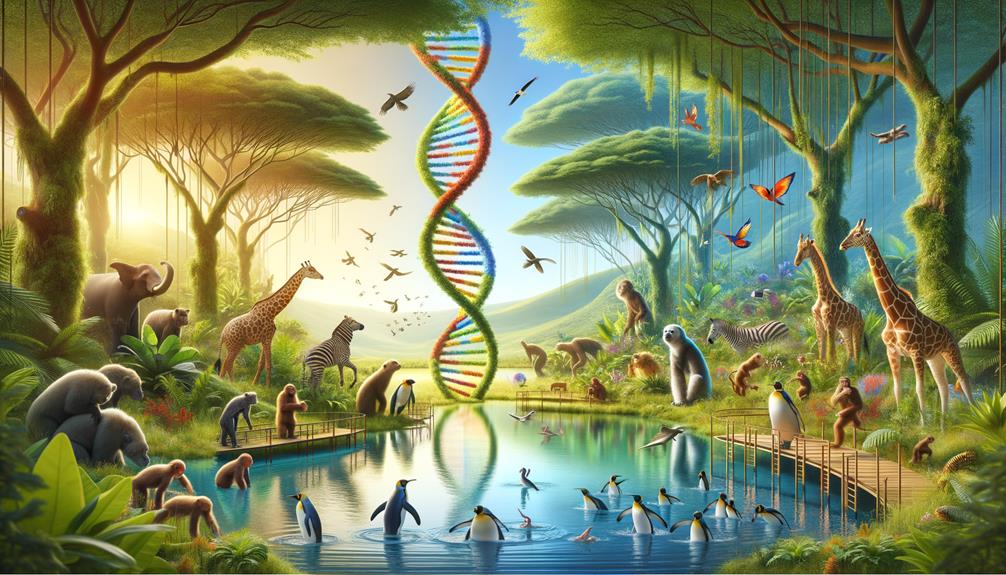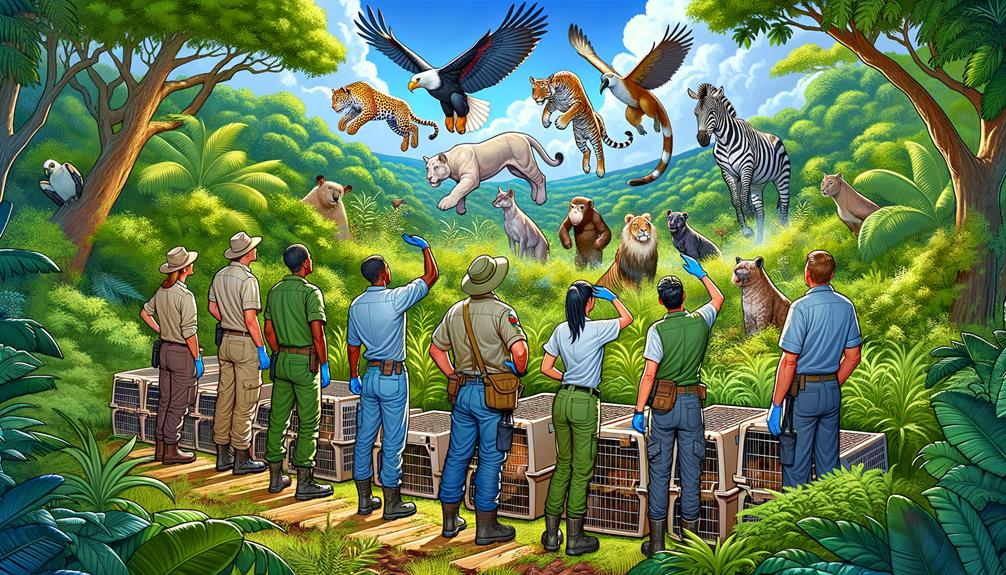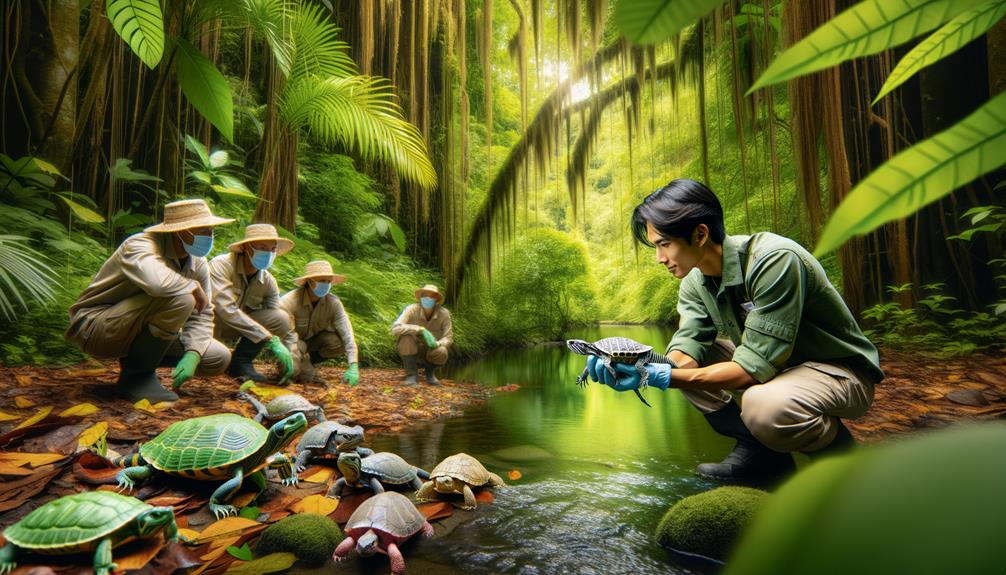I'm genuinely impressed by the success of captive breeding programs. These initiatives have literally brought species back from the edge of extinction, like the Arabian oryx and California condor. By carefully managing genetic diversity, they've ensured robust populations. The swift fox has been stabilized, and over 8,000 black-footed ferrets have been reintroduced into the wild. These programs employ meticulous strategies to prevent inbreeding and provide innovative survival training, guaranteeing long-term viability. They play a crucial role in preserving our planet's biodiversity and are vital to future restoration efforts. If you're interested in learning more about the intricacies and challenges ahead, there's much to explore.
Key Takeaways
The Arabian oryx population has seen a remarkable rebound, growing from just 9 individuals to over 200 in the wild, thanks to successful captive breeding efforts.
The California condor population has also experienced a significant increase, rising from 27 to over 500, due to effective reintroduction programs.
Swift fox populations have stabilized, eliminating the need for Endangered Species Act listing.
Since the 1990s, over 8,000 black-footed ferrets have been successfully reintroduced into the wild.
To combat inbreeding and ensure the long-term health of these populations, conservationists use DNA analysis and selective breeding to manage genetic diversity.
Key Success Stories
One of the most notable success stories in conservation is the remarkable recovery of the Arabian oryx. From a fragile population of just nine individuals, the species has made a stunning comeback, with over 200 thriving in the wild today. This achievement showcases the power of captive breeding programs in saving endangered species from extinction. It's truly remarkable to think that such a small group of oryxes could lead to a flourishing population, thanks to meticulous wildlife conservation and reintroduction efforts.
Captive breeding and conservation have also played a crucial role in rescuing the California condor. Once on the brink of extinction, with numbers alarmingly low, the population has now grown to over 500 birds living in the wild or in captivity. The swift fox is another example of the effectiveness of these programs, with numbers stabilizing to the point where they no longer require listing under the Endangered Species Act.
The Foskett speckled dace, once confined to a single spring, was successfully translocated to create a refuge population, leading to its removal from the endangered species list. Similarly, habitat restoration has allowed the Karner blue butterfly population to rebound, highlighting the significant impact of these conservation efforts.
Genetic Diversity Maintenance

While we celebrate conservation successes, we must also acknowledge the critical role of genetic diversity in ensuring the long-term viability of captive breeding programs. Without this diversity, populations are at risk of inbreeding depression, which can severely limit their adaptive potential. Genetic management techniques are essential in addressing this issue.
By carefully selecting breeding pairs based on pedigree records, we can prevent closely related individuals from mating, thereby preserving the genetic health of the population. DNA analysis is another vital tool that helps track and manage genetic diversity, making our reintroduction efforts more effective. This analysis enables us to make informed decisions about mating pairs, avoiding genetic bottlenecks and fostering a resilient population.
Occasionally, it's necessary to introduce new genetic material into captive breeding programs. This can be achieved by integrating wild individuals into the program, which helps combat the loss of diversity that can occur over generations in captivity. This gene pool refreshment is vital for maintaining a healthy, adaptable population.
These meticulous strategies ensure that our captive breeding programs produce robust, genetically diverse populations. By doing so, we give these magnificent creatures the best possible chance of thriving in the wild.
Reintroduction Efforts

Reintroduction efforts have led to the revival of endangered species like the Arabian Oryx, California Condor, and Przewalski's Horse, demonstrating the power of meticulous conservation strategies. Through captive breeding and reintroduction, we've seen remarkable population recoveries. For example, the California Condor's wild population has grown from just 27 birds in the 1990s to over 500 today, highlighting the importance of habitat restoration and adaptive management.
The black-footed ferret's resurgence is another testament to these efforts. Since the 1990s, over 8,000 ferrets have been reintroduced into their natural habitat. Teaching survival skills and careful preparation are crucial for these animals. Monitoring and adaptive management of reintroduction sites ensure that these populations remain viable.
In wildlife conservation, it's not just about numbers; it's about resilience and survival rates. Programs like those for the Przewalski's Horse show how adaptive management and constant monitoring can foster long-term stability. When we commit to reintroduction, we're not just saving species; we're restoring ecosystems and reaffirming the intrinsic value of every living being. We're proving that with dedication, we can turn the tide for endangered species.
Role in Conservation

Captive breeding programs have become essential in modern conservation, preserving genetic diversity and providing a safety net for species on the brink of extinction. These initiatives have successfully recovered endangered species like the Arabian oryx and California condor, transforming dire population declines into stories of survival.
The success of captive breeding is evident not just in numbers, but in the depth of knowledge gained. By understanding the biology and behavior of species, we've developed more effective conservation strategies tailored to each unique challenge. The recovery of the red wolf and golden lion tamarin demonstrates how genetic diversity and survival skills learned in captivity can lead to successful reintroduction and population recovery.
| Species | Breeding Success | Reintroduction | Population Boost |
|---|---|---|---|
| Arabian oryx | High | Successful | Substantial |
| California condor | Moderate | Ongoing | Significant |
| Black-footed ferret | High | Successful | Substantial |
| Golden lion tamarin | Moderate | Successful | Noticeable |
Captive breeding is more than just a temporary solution; it's a crucial part of long-term conservation efforts and habitat restoration. By preserving genetic diversity and honing survival skills, we're giving these species a fighting chance at thriving once more.
Future Challenges

Ensuring the future success of captive breeding programs requires addressing significant challenges. One major concern is maintaining genetic diversity within these programs. This diversity is crucial for the health of any population, as it helps prevent inbreeding and ensures animals can adapt to environmental changes and disease outbreaks.
Another significant hurdle is preparing animals for life in the wild. Captive-bred animals often lack the necessary survival skills, which can make it difficult for them to integrate into existing populations. Effective training programs and release strategies are essential to ensure these animals thrive once reintroduced.
Securing sufficient funding and resources is an ongoing challenge. Monitoring and adaptive management strategies require significant investment. We need consistent financial support to conduct research, track population recovery, and refine our approaches.
Disease outbreaks in captive facilities can have devastating consequences, jeopardizing years of conservation work. Implementing rigorous health protocols and continuous monitoring is vital to mitigate these risks.
Frequently Asked Questions
What Are Some Examples of Successful Captive Breeding Programs?
I've seen remarkable successes like the Arabian Oryx, California Condor, black-footed ferret, golden lion tamarin, and red wolf. These species, once on the brink, now flourish thanks to dedicated conservation efforts and breeding programs led by passionate individuals.
What Are the Pros of Captive Breeding Programs?
Captive breeding programs offer a vital safety net for endangered species. By protecting them and maintaining genetic diversity, these programs provide crucial data for wild population recovery, ultimately supporting their freedom and survival.
What Are the Goals of a Captive Breeding Program?
Captive breeding programs have a few key objectives. They aim to increase the populations of endangered species, maintain genetic diversity, and improve the success of reintroduction efforts. Additionally, these programs focus on research and public education, ensuring that these species thrive in the wild and garnering public support for their conservation.
What Are the Advantages of Breeding Programs?
Breeding programs have numerous benefits. By increasing genetic diversity, they ensure species survival and support reintroduction efforts. Additionally, they provide a safeguard for endangered species, giving them a chance to thrive.



